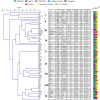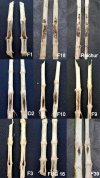Morphological characterization, pathogenicity screening, and molecular identification of Fusarium spp. isolates causing post-flowering stalk rot in maize
- PMID: 37065162
- PMCID: PMC10102488
- DOI: 10.3389/fmicb.2023.1121781
Morphological characterization, pathogenicity screening, and molecular identification of Fusarium spp. isolates causing post-flowering stalk rot in maize
Abstract
Post flowering stalk rot (PFSR) of maize caused by the Fusarium species complex is a serious threat to maize production worldwide. The identification of Fusarium species causing PFSR based on morphology traditionally relies on a small set of phenomic characteristics with only minor morphological variations among distinct Fusarium species. Seventy-one isolates were collected from 40 sites in five agro-climatic zones of India to assess the diversity of Fusarium spp. associated with maize crops showing symptoms of PFSR in the field. To investigate the pathogenicity of Fusarium spp. causing PFSR sixty isolates were toothpick inoculated between the first and second node at 55 days after sowing during the tassel formation stage of the crop in Kharif (Rainy season), and Rabi (Winter season) season field trials. Ten most virulent Fusarium isolates, based on the highest observed disease index, were identified by homology and phylogenetic analyses of partial sequences of the translation elongation factor 1 α (Tef-1α). Based on morphological traits such as mycelial growth patterns and mycelial pigmentation, Fusarium isolates were divided into nine clusters. The isolates were judged to be virulent based on their ability to decrease seedling vigour in in-vivo situations and high disease severity in field experiments. Pathogenicity test during the Kharif season showed 12 isolates with virulent disease symptoms with a mean severity ranging between 50 to 67 percent disease index (PDI) whereas in Rabi season, only five isolates were considered virulent, and the mean severity ranged between 52 to 67 PDI. Based on pathological characterization and molecular identification, 10 strains of Fusarium species namely, Fusarium acutatum (2/10), Fusarium verticillioides (Syn. Gibberella fujikuroi var. moniliformis) (7/10), Fusarium andiyazi (2/10) recorded the highest diseases index. All these species are part of the Fusarium fujikuroi species complex (FFSC). The distribution of virulent isolates is specific to a geographical location with a hot humid climate. Increased knowledge regarding the variability of Fusarium spp. responsible for PFSR of maize occurring across wide geographical locations of India will enable more informed decisions to be made to support the management of the disease, including screening for resistance in maize-inbred lines.
Keywords: Fusarium; PFSR; maize; molecular characterization; morphology; pathogenicity; soilborne pathogens; translation elongation factor 1 α.
Copyright © 2023 Harish, Jambhulkar, Bajpai, Arya, Babele, Chaturvedi, Kumar and Lakshman.
Conflict of interest statement
The authors declare that the research was conducted in the absence of any commercial or financial relationships that could be construed as a potential conflict of interest.
Figures









 Fusarium verticillioides;
Fusarium verticillioides;  Fusarium andiyazi;
Fusarium andiyazi;  Fusarium acutatum.
Fusarium acutatum.Similar articles
-
Identification, Pathogenicity, and Genetic Diversity of Fusarium spp. Associated with Maize Sheath Rot in Heilongjiang Province, China.Int J Mol Sci. 2022 Sep 16;23(18):10821. doi: 10.3390/ijms231810821. Int J Mol Sci. 2022. PMID: 36142733 Free PMC article.
-
Fungal Pathogens Associated with Crown and Root Rot in Wheat-Growing Areas of Northern Kyrgyzstan.J Fungi (Basel). 2023 Jan 16;9(1):124. doi: 10.3390/jof9010124. J Fungi (Basel). 2023. PMID: 36675945 Free PMC article.
-
Phylogenetic analysis of plant-pathogenic and non-pathogenic Trichoderma isolates on maize from plants, soil, and commercial bio-products.Appl Environ Microbiol. 2025 Mar 19;91(3):e0193124. doi: 10.1128/aem.01931-24. Epub 2025 Feb 27. Appl Environ Microbiol. 2025. PMID: 40013788 Free PMC article.
-
Systemic pharmacological treatments for chronic plaque psoriasis: a network meta-analysis.Cochrane Database Syst Rev. 2017 Dec 22;12(12):CD011535. doi: 10.1002/14651858.CD011535.pub2. Cochrane Database Syst Rev. 2017. Update in: Cochrane Database Syst Rev. 2020 Jan 9;1:CD011535. doi: 10.1002/14651858.CD011535.pub3. PMID: 29271481 Free PMC article. Updated.
-
Systemic pharmacological treatments for chronic plaque psoriasis: a network meta-analysis.Cochrane Database Syst Rev. 2021 Apr 19;4(4):CD011535. doi: 10.1002/14651858.CD011535.pub4. Cochrane Database Syst Rev. 2021. Update in: Cochrane Database Syst Rev. 2022 May 23;5:CD011535. doi: 10.1002/14651858.CD011535.pub5. PMID: 33871055 Free PMC article. Updated.
Cited by
-
Virulent Fusarium isolates with diverse morphologies show similar invasion and colonization strategies in alfalfa.Front Plant Sci. 2024 May 17;15:1390069. doi: 10.3389/fpls.2024.1390069. eCollection 2024. Front Plant Sci. 2024. PMID: 38828216 Free PMC article.
-
Stalk rot species diversity and molecular phylogeny associated with diseased maize in India.World J Microbiol Biotechnol. 2024 Apr 29;40(6):185. doi: 10.1007/s11274-024-03991-3. World J Microbiol Biotechnol. 2024. PMID: 38683236
-
Assessment of Genetic Diversity and the Population Structure of Species from the Fusarium fujikuroi Species Complex Causing Fusarium Stalk Rot of Maize.J Fungi (Basel). 2024 Aug 14;10(8):574. doi: 10.3390/jof10080574. J Fungi (Basel). 2024. PMID: 39194900 Free PMC article.
-
Epidemiology and Genetic Relationship of Toxigenic Fungi in Maize Grains From North Central Nigerian States.Environ Health Insights. 2024 May 6;18:11786302241249858. doi: 10.1177/11786302241249858. eCollection 2024. Environ Health Insights. 2024. PMID: 38721401 Free PMC article.
-
Identification and green synthesis of potato dry rot Fusarium falciforme silver nanoparticles, characterization and antibacterial activity.BMC Plant Biol. 2025 Aug 23;25(1):1120. doi: 10.1186/s12870-025-07124-2. BMC Plant Biol. 2025. PMID: 40847275 Free PMC article.
References
-
- Chandra Nayaka S., Niranjana S., Uday Shankar A., Niranjan Raj S., Reddy M., Prakash H., et al. (2010). Seed biopriming with novel strain of Trichoderma harzianum for the control of toxigenic Fusarium verticillioides and fumonisins in maize. Arch. Phytopathol. Pflanzenschutz 43 264–282. 10.1080/03235400701803879 - DOI
-
- Chandra Nayaka S., Udaya Shankar A., Niranjana S., Prakash H. (2008). Molecular detection and characterization of Fusarium verticillioides in maize (Zea mays. L) grown in southern India. Ann. Microbiol 58 359–367. 10.1007/BF03175529 - DOI
-
- Chaube H., Singh U. (1991). Plant Disease Management: Principles and Practices. Boca Raton, FL: CRC Press.
-
- Chester K. (1950). Plant disease losses: their appraisal and interpretation. Plant Dis Rep. 193 190–362.
LinkOut - more resources
Full Text Sources
Miscellaneous

